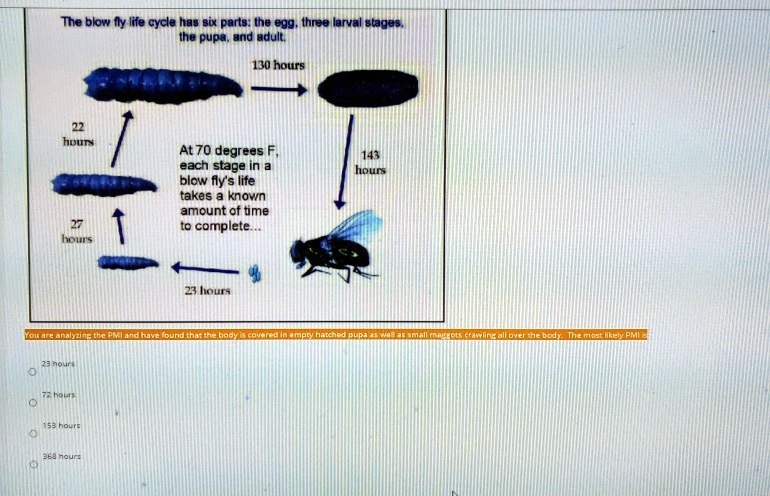The blowfly life cycle has six parts: the egg, three larval stages, the pupa, and the adult. At 70 degrees F, each stage in the blowfly’s life takes a known amount of time to complete: 130 hours for the egg and larval stages, and 143 hours for the pupa stage.

The Correct Answer and Explanation is:
Correct Answer: 273 hours
Explanation:
To estimate the postmortem interval (PMI) using blowfly development, forensic entomologists observe which stages of the insect life cycle are present on a body. In this case, the image outlines the blowfly’s life cycle as follows:
- Egg stage: 23 hours
- First instar larva: 27 hours
- Second instar larva: 22 hours
- Third instar larva: 130 hours (cumulative for all three larval stages)
- Pupa stage: 143 hours
- Adult fly: Emerges after the pupa stage
The question states that the body is covered in empty hatched pupal cases as well as small maggots (larvae). This tells us two important facts:
- Some blowflies have already completed their full life cycle and become adults, leaving behind hatched pupa.
- New generations have also laid eggs that have developed into maggots.
This means that at least one generation of blowflies has completed its development through the egg, larval, and pupal stages and reached adulthood. According to the timeline given at 70°F, the time required to go from egg to adult is:
- Larval stages (all three stages combined): 130 hours
- Pupal stage: 143 hours
Total: 130 + 143 = 273 hours
Because we see both newly hatched maggots and empty pupal cases, it strongly suggests the body has been present for at least the time it takes for a full blowfly life cycle. Therefore, the most likely PMI is 273 hours, which is roughly 11.4 days. This estimate assumes a consistent temperature of 70°F, which is crucial since insect development is temperature-dependent.
